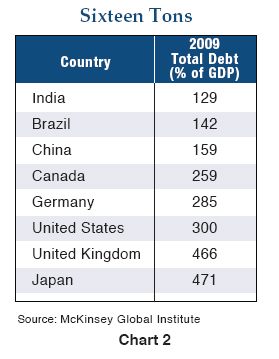最新一期的PIMCO投资展望提到了金融危机的后果:更多的负债、高失业率、低增长以及去杠杆化。Bill Gross引用了两个研究:
第一个研究:
This Time is Different
Carmen Reinhart 和 Kenneth Rogoff 合作撰写的书,研究了过去8个世纪的金融危机,主要关注公共债务。这本书认为金融危机的影响有三点:
1. 银行危机的真正的后遗症是公共债务的增加。这些债务的增加远远超过政府提供直接救援所花费的数额。平均而言,一个国家的债务在危机后的三年内接近翻倍。
The true legacy of banking crises is greater public indebtedness, far beyond the direct headline costs of bailout packages. On average a country’s outstanding debt nearly doubles within three years following the crisis.
2. 银行危机的后果是平均增加7%的失业率,而且持续高失业率达5年。
The aftermath of banking crises is associated with an average increase of seven percentage points in the unemployment rate, which remains elevated for five years.
3. 一旦一个国家的公共债务超过90%的GDP,这个国家的经济增长会降低1个百分点。
Once a country’s public debt exceeds 90% of GDP, its economic growth rate slows by 1%.
根据公共债务以及赤字和GDP的关系,Bill Gross画了一个图。

可以看出,处于“火圈”中的国家都处于公共债务的水深火热之中,未来经济增长受到威胁。
第二个研究:
Debt and deleveraging: The global credit bubble and its economic consequences.
这是麦肯锡研究院的研究,主要关注经济的整体负债,研究了32个经济危机后的去杠杆化的例子。
这个研究的结论有三点:
1. 典型的去杠杆化在经济危机(如2008年)开始后两年开始,持续6-7年。
Typically deleveraging begins two years after the beginning of the crisis (2008 in this case) and lasts for six to seven years.
2. 在一半的情况下去杠杆化造成了长期的紧缩开支并显著拖累了GDP增长。在另一半的情况下,去杠杆化造成了企业及政府债务的拖欠或者通货膨胀,这些对投资者来说都是诅咒。
In about 50% of the cases the deleveraging results in a prolonged period of belt-tightening exerting a significant drag on GDP growth. In the remainder, deleveraging results in a base case of outright corporate and sovereign defaults or accelerating inflation, all of which are anathema to an investor.
3. 一个国家总债务的初始状态非常重要。(债务水平越高,去杠杆化越难。)
Initial conditions are important.

可以看出美国的总债务占GDP的比例为300%,去杠杆化还有很长的路要走。
我认为这两个研究对中国也很有借鉴意义。人民银行的数据显示,中国目前贷款总额约为42万亿,国债约为5万亿,企业债约为7千亿,总债务约为47.7万亿。由于基建的原因,如果2010年再增加7.5万亿新的贷款,加上财政赤字1万亿带来的增发1万亿国债。企业债去年发了4千亿,今年至少5千亿。这样算下来,中国总债务将达到56.7万亿,达到GDP的160%左右。而2008年中国的债务总额仅为GDP的120%左右,短短两年的时间里总债务占GDP的比例提高了20个百分点。西方国家是在去杠杆化,我们是在加速杠杆化。
0
推荐




 京公网安备 11010502034662号
京公网安备 11010502034662号 